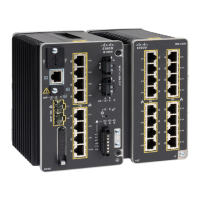32-30
Cisco IE 3000 Switch Software Configuration Guide
OL-13018-01
Chapter 32 Configuring QoS
Configuring Standard QoS
Standard QoS Configuration Guidelines
Before beginning the QoS configuration, you should be aware of this information in these sections:
• “QoS ACL Guidelines” section on page 32-30
• “Policing Guidelines” section on page 32-30
• “General QoS Guidelines” section on page 32-31
QoS ACL Guidelines
These are the guidelines with for configuring QoS with access control lists (ACLs):
• If you use QoS ACLs for classification, you can use the sdm prefer qos global configuration
command to set the Switch Database Management (SDM) feature to the QoS template. SDM
configures system resources to support the maximum number of access control entries (ACEs). For
more information on the SDM templates, see
Chapter 8, “Configuring SDM Templates.”
• It is not possible to match IP fragments against configured IP extended ACLs to enforce QoS. IP
fragments are sent as best-effort. IP fragments are denoted by fields in the IP header.
• Only one ACL per class map and only one match class-map configuration command per class map
are supported. The ACL can have multiple ACEs, which match fields against the contents of the
packet.
• A trust statement in a policy map requires multiple TCAM entries per ACL line. If an input service
policy map contains a trust statement in an ACL, the access-list might be too large to fit into the
available QoS TCAM and an error can occur when you apply the policy map to a port. Whenever
possible, you should minimize the number of lines in a QoS ACL.
Policing Guidelines
These are the policing guidelines:
• The port ASIC device, which controls more than one physical port, supports 256 policers (255
user-configurable policers plus 1 policer reserved for system internal use). The maximum number
of user-configurable policers supported per port is 63. Policers are allocated on demand by the
software and are constrained by the hardware and ASIC boundaries. You cannot reserve policers per
port; there is no guarantee that a port will be assigned to any policer.
• Only one policer is applied to a packet on an ingress port. Only the average rate and committed burst
parameters are configurable.
• You can set the policing rate only in 1-Mb/s increments. If you try to set a policing rate at less
than1
Mb/s, the switch prompts you for a correct value.
• On a port configured for QoS, all traffic received through the port is classified, policed, and marked
according to the policy map attached to the port. On a trunk port configured for QoS, traffic in all
VLANs received through the port is classified, policed, and marked according to the policy map
attached to the port.
• If you have EtherChannel ports configured on your switch, you must configure QoS classification,
policing, mapping, and queueing on the individual physical ports that comprise the EtherChannel.
You must decide whether the QoS configuration should match on all ports in the EtherChannel.
